The BPRS-E as Predictor of Length of Stay in a Residential Facility
To the Editor: In a study carried out in a long-stay psychiatric setting, Anderson and colleagues (1) showed that negative symptoms recorded with the Brief Psychiatric Rating Scale-Expanded Version (BPRS-E) (2) were helpful in predicting length of stay. However, it is uncertain whether this study's findings can be applied to other populations of psychiatric patients. We evaluated the role of the BPRS-E in predicting inpatient length of stay in a sample of patients that was representative of the psychiatric population in the town of Ferrara, Northern Italy. The study participants were patients who were consecutively admitted to the only residential facility for short- to medium-term psychiatric care in the town during a 14-month period.
Patients with mental retardation were excluded. The institutional review board of the health agency approved this study, and written informed consent was obtained.
Upon the patient's admission, we documented sociodemographic and clinical data, ICD-10 psychiatric diagnosis, and duration of illness. The BPRS-E was administered by the first author. The BPRS-E items were subjected to a principal-components analysis with varimax rotation and Kaiser normalization. Linear regression analysis was run to assess the association between the dependent variable, length of stay in the facility, and the independent variables, age in years, sex (male, 0, or female, 1), whether the patient lived alone (no, 0, or yes, 1), duration of illness in years, diagnosis (ICD-10 codes in the F2, F3, F4, or F6 category), number of previous admissions, and BPRS-E factors derived from factorial analysis. A nonparametric bootstrap method of statistical accuracy was used, with the assumption that the observed distribution of the sample used in this study was a good estimate of the true population distribution (3).
The study sample was composed of 66 men (42 percent) and 91 women (58 percent). The mean±SD age was 46.7±13.5 years. More than one-third of the sample had never married (60 participants, or 38 percent) and lived with their own families (64 participants, or 41 percent). Seventy-six patients had affective disorders (48 percent), 50 had psychotic disorders (32 percent), 28 had personality disorders (18 percent), and three had neurotic disorders (2 percent). The mean duration of illness at baseline was 17.9±11.7 years. The mean length of stay in the facility was 49.9±47.4 days (median stay of 35 days, range of three to 258 days).
Factorial analysis used item coefficient loadings greater than .40 and all post-rotated eigenvalues above 1.0. Factorial analysis produced six BPRS-E factors. Factor 1 (positive symptoms) included grandiosity, suspiciousness, hallucinations, unusual thought content, bizarre behavior, mannerisms and posturing, and conceptual disorganization. Factor 2 (manic symptoms) included elevated mood, disorientation, tension, excitement, distractibility, and motor hyperactivity. Factor 3 (negative symptoms) included self-neglect, blunted affect, emotional withdrawal, and motor retardation. Factor 4 (depressive symptoms) included depression, suicidality, and guilt. Factor 5 (patients' resistance to treatment) included hostility and uncooperativeness. Factor 6 (anxiety symptoms) included somatic concern and anxiety. The results of the bootstrap linear regression analysis showed that demographic and clinical variables were not associated with length of stay and that negative symptoms were positively associated with length of stay (coefficient=3.28, bias-corrected 95 percent CI=.96 to 5.93, p<.05; 22 percent of the variance explained).
The finding that negative symptoms were positively associated with length of stay expands previous evidence (1) to a different, more heterogeneous and nonselected population of severely ill psychiatric patients. Age, sex, living conditions, duration of illness, diagnosis, and number of previous admissions were not associated with length of stay, thus giving further relevance to the possibility of predicting length of stay by administering the BPRS-E upon patient admission.
Dr. Biancosino is attending psychiatrist and Dr. Grassi is professor of psychiatry in the section of psychiatry of the department of medical sciences of communication and behavior at the University of Ferrara and the Department of Mental Health, Local Health Agency in Ferrara, Italy. Dr. Barbui is assistant professor of psychiatry in the section of psychiatry and clinical psychology in the department of medicine and public health at the University of Verona.
1. Anderson SW, Crist AJ, Payne N: Predicting inpatient length of stay with the Expanded Version of the Brief Psychiatric Rating Scale (Version 4.0). Psychiatric Services 55:77–79,2004Link, Google Scholar
2. Ventura J, Lukoff D, Nuechterlein KH, et al: Appendix 1: Brief Psychiatric Rating Scale Expanded Version (4.0) scales, anchor points, and administration manual. International Journal of Methods in Psychiatric Research 3:227–243,1993Google Scholar
3. Efron B, Tibshirani R: Bootstrap methods of standard errors, confidence intervals, and other measures of statistical accuracy. Statistical Science 1:54–77,1986Crossref, Google Scholar



